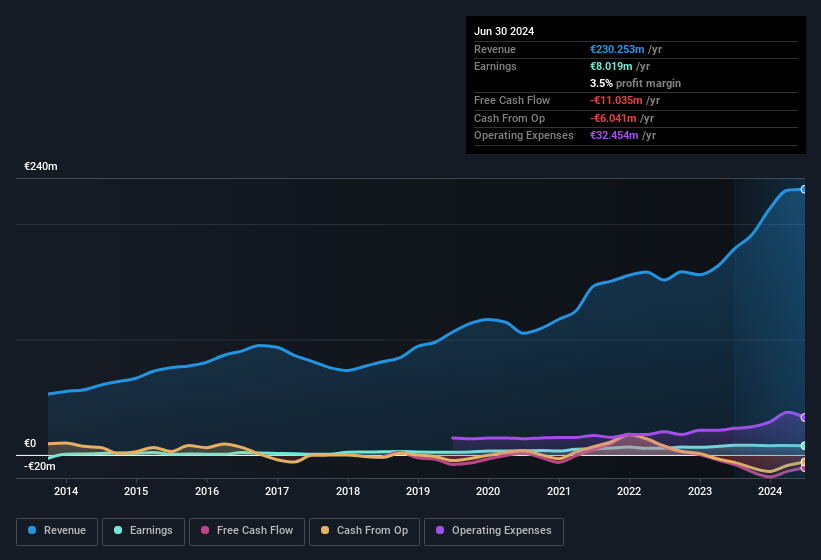Petros Petropoulos AEBE's (ATH:PETRO) Anemic Earnings Might Be Worse Than You Think

Petros Petropoulos AEBE's (ATH:PETRO) recent weak earnings report didn't cause a big stock movement. Our analysis suggests that along with soft profit numbers, investors should be aware of some other underlying weaknesses in the numbers.
See our latest analysis for Petros Petropoulos AEBE

Zooming In On Petros Petropoulos AEBE's Earnings
One key financial ratio used to measure how well a company converts its profit to free cash flow (FCF) is the accrual ratio. The accrual ratio subtracts the FCF from the profit for a given period, and divides the result by the average operating assets of the company over that time. This ratio tells us how much of a company's profit is not backed by free cashflow.
That means a negative accrual ratio is a good thing, because it shows that the company is bringing in more free cash flow than its profit would suggest. While it's not a problem to have a positive accrual ratio, indicating a certain level of non-cash profits, a high accrual ratio is arguably a bad thing, because it indicates paper profits are not matched by cash flow. To quote a 2014 paper by Lewellen and Resutek, "firms with higher accruals tend to be less profitable in the future".
Petros Petropoulos AEBE has an accrual ratio of 0.28 for the year to June 2024. Unfortunately, that means its free cash flow was a lot less than its statutory profit, which makes us doubt the utility of profit as a guide. Even though it reported a profit of €8.02m, a look at free cash flow indicates it actually burnt through €11m in the last year. We also note that Petros Petropoulos AEBE's free cash flow was actually negative last year as well, so we could understand if shareholders were bothered by its outflow of €11m.
Note: we always recommend investors check balance sheet strength. Click here to be taken to our balance sheet analysis of Petros Petropoulos AEBE.
Our Take On Petros Petropoulos AEBE's Profit Performance
Petros Petropoulos AEBE's accrual ratio for the last twelve months signifies cash conversion is less than ideal, which is a negative when it comes to our view of its earnings. Because of this, we think that it may be that Petros Petropoulos AEBE's statutory profits are better than its underlying earnings power. But at least holders can take some solace from the 50% per annum growth in EPS for the last three. The goal of this article has been to assess how well we can rely on the statutory earnings to reflect the company's potential, but there is plenty more to consider. With this in mind, we wouldn't consider investing in a stock unless we had a thorough understanding of the risks. Case in point: We've spotted 4 warning signs for Petros Petropoulos AEBE you should be mindful of and 2 of these shouldn't be ignored.
Today we've zoomed in on a single data point to better understand the nature of Petros Petropoulos AEBE's profit. But there is always more to discover if you are capable of focussing your mind on minutiae. For example, many people consider a high return on equity as an indication of favorable business economics, while others like to 'follow the money' and search out stocks that insiders are buying. So you may wish to see this free collection of companies boasting high return on equity, or this list of stocks with high insider ownership.
If you're looking to trade Petros Petropoulos AEBE, open an account with the lowest-cost platform trusted by professionals, Interactive Brokers.
With clients in over 200 countries and territories, and access to 160 markets, IBKR lets you trade stocks, options, futures, forex, bonds and funds from a single integrated account.
Enjoy no hidden fees, no account minimums, and FX conversion rates as low as 0.03%, far better than what most brokers offer.
Sponsored ContentNew: Manage All Your Stock Portfolios in One Place
We've created the ultimate portfolio companion for stock investors, and it's free.
• Connect an unlimited number of Portfolios and see your total in one currency
• Be alerted to new Warning Signs or Risks via email or mobile
• Track the Fair Value of your stocks
Have feedback on this article? Concerned about the content? Get in touch with us directly. Alternatively, email editorial-team (at) simplywallst.com.
This article by Simply Wall St is general in nature. We provide commentary based on historical data and analyst forecasts only using an unbiased methodology and our articles are not intended to be financial advice. It does not constitute a recommendation to buy or sell any stock, and does not take account of your objectives, or your financial situation. We aim to bring you long-term focused analysis driven by fundamental data. Note that our analysis may not factor in the latest price-sensitive company announcements or qualitative material. Simply Wall St has no position in any stocks mentioned.
About ATSE:PETRO
Petros Petropoulos AEBE
Engages in the manufacture, modification, distribution, and support of various automotive products in Greece and internationally.
Excellent balance sheet, good value and pays a dividend.
Market Insights
Community Narratives




